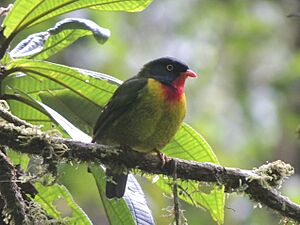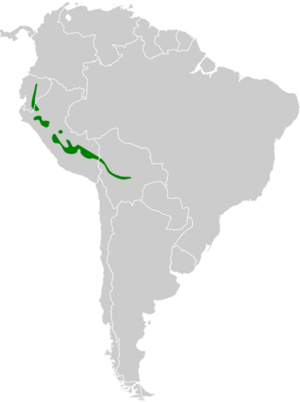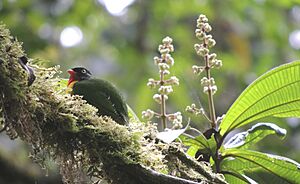Scarlet-breasted fruiteater facts for kids
Quick facts for kids Scarlet-breasted fruiteater |
|
|---|---|
 |
|
| Male P. f. squamipectus | |
| Conservation status | |
| Scientific classification | |
| Genus: |
Pipreola
|
| Species: |
frontalis
|
 |
|
The scarlet-breasted fruiteater (Pipreola frontalis) is a colorful bird found in South America. It belongs to the Cotingidae family, which includes many bright and unique birds. You can find this bird in Bolivia, Ecuador, and Peru. It lives in wet, tropical montane forests, which are forests on mountains.
This bird is plump and mostly green. Males have a bright red throat and chest, while females have yellow underparts with green spots. There are two types, or subspecies, of this bird. The scarlet-breasted fruiteater is quite common in its home range. Because of this, the International Union for Conservation of Nature says it is a "least concern" species. This means it is not currently in danger of disappearing.
Contents
About the Scarlet-breasted Fruiteater
The scarlet-breasted fruiteater was first described by a British ornithologist (bird expert) named Philip Sclater in 1858. It is one of eleven species in the Pipreola group, also known as fruiteaters. This bird is related to the fiery-throated fruiteater. However, it lives in higher places on the mountains.
There are two main types of scarlet-breasted fruiteaters:
- P. f. frontalis: This type lives in central Peru and western Bolivia.
- P. f. squamipectus: This type is found from northern Ecuador to northwestern Peru. It was described by Frank Chapman in 1925. This subspecies is a bit smaller and less colorful than the frontalis type.
The name Pipreola comes from Pipra, which is the name for a group of birds called manakins. They have a similar shape. The second part of its name, frontalis, is a Latin word. It means "fronted" or "browed," likely referring to its head or chest.
What Does It Look Like?
The scarlet-breasted fruiteater is a plump bird with a short tail. It is a type of cotinga. It is fairly small for a fruiteater, growing to about 15.5 to 16.5 centimeters (6 to 6.5 inches) long. It usually weighs between 39.5 and 45.3 grams (about 1.4 to 1.6 ounces).
Males and females look different, which is called sexually dimorphic. The male is much more colorful than the female. Both sexes have bright green feathers on their upper bodies. They also have thin yellow tips on some of their wing feathers.
The male's throat and upper chest are a bright red. The red color is a bit less spread out in the P. f. squamipectus type. The female's underparts are yellow. They have green scales or spots. Both male and female birds have pink or orange legs and feet.
Where Do They Live?
The scarlet-breasted fruiteater lives only on the eastern side of the Andes mountains. This area stretches from northeastern Ecuador through eastern Peru to central Bolivia. These birds live in mountain forests. They are found at heights from 900 to 2,000 meters (about 2,950 to 6,560 feet) above sea level.
How They Behave
The scarlet-breasted fruiteater spends most of its time in trees. This is called being arboreal. They often stay higher up in the trees, from the middle levels to just below the very top branches. Many other fruiteaters stay lower down. Like other fruiteaters, they tend to be quite calm and not very active.
What Do They Eat?
As their name suggests, scarlet-breasted fruiteaters mainly eat fruit. They usually pick fruit while hovering in the air. Less often, they will pick fruit while sitting on a branch.
What Do They Sound Like?
The sounds made by the scarlet-breasted fruiteater are usually short, high-pitched, and not very frequent. The male P. f. squamipectus sings a sharp, rising sound. It sounds like "psii" or "tsweeet". The male P. f. frontalis has a longer and more complex song. It is a thin, rising trill that then becomes a falling whistle. It sounds like "ti'ti'ti'ti'ti'ti'tseeeeeeeeer". Their call is a very high-pitched "pseet".
Conservation Status
The International Union for Conservation of Nature (IUCN) has listed the scarlet-breasted fruiteater as a species of "least concern". This is because it lives across a very large area. It is also a fairly common bird within that area.
However, we don't know exactly how many of these birds there are. Scientists believe their numbers might be slowly going down.



